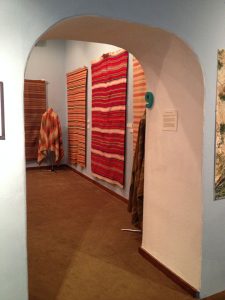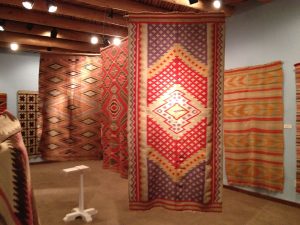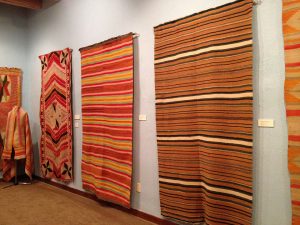I arranged a visit with Carmela Quinto, Curator of Collections at the Millicent Rogers Museum (MRM) in Taos, NM, and met with her on Thursday September 27, 2018.
After brief introductions, we started right in on the many topics on which I had requested information, because there was so much to see and learn. As Carmela showed, demonstrated, and explained, I scribbled notes and took some pictures. We began with the storage area which is quite large relative to the storage we have at the Luther Bean Museum, but already filled with the collections of the MRM.
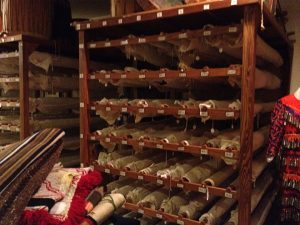
Textile storage at the Millicent Rogers Museum
Weavings and textiles are arranged in groupings of: Navajo, Pueblo, Hispanic, and Mexican. They are stored on very large custom-built racks, each approximately a seven to eight-foot cube in area, with rows of horizontal wood poles instead of shelves. Storing the weavings on these wood poles involves layers of materials to protect the textiles. The wood poles are wrapped in a tube of cardboard or PVC, then in acid-free tissue. The textile is wrapped around the tissue and then encased in cotton muslin which is longer than the textile. Finally, the muslin is tied at its ends with cotton ties, tightly, to keep out moths and insects.
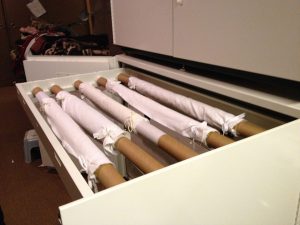
Small textile storage
Small textiles are stored on much smaller versions of the horizontal wood poles, in drawers within cabinets. These are stored just as carefully with the layers of acid-free materials, and even though they are inside of a cabinet, are wrapped in the muslin with the cotton ties.
Because the MRM building was originally a courtyard home, it is not as tightly constructed as a modern museum structure might be. Moths are the biggest pest the museum faces in terms of its textiles, and the museum has developed storage and fumigation strategies to safeguard its collections.

Airspace between the wall and textile
An additional strategy has been to hang the display textiles away from the walls so that moths do not have a dark, seemingly enclosed place in which to hide. This airspace of about two inches also allows the staff to mildly shake each textile periodically to disturb any moth that may have temporarily stopped there. The textiles are hung by sliding a flat metal bar through a muslin sleeve that has been sewn to the back of the textile.
The MRM used grant funding to bring in experts to identify and classify many of their collections. Suzanne Baizerman, PhD, was brought in to identify, classify and assess the condition of weavings and textiles. Carmela has done much of the identification and assessment of the Hispanic sacred Retablos (3-dimensional carvings or sculptures of saints, usually painted) and Bultos (2-dimensional, often wood or metal, painted with images of saints), and this is her area of specialization.
All of the objects in the MRM collections have been photographed for documentation. This is different than photographing for publication. The documentation photography is for identification of the objects and the photographs are included in their database.

